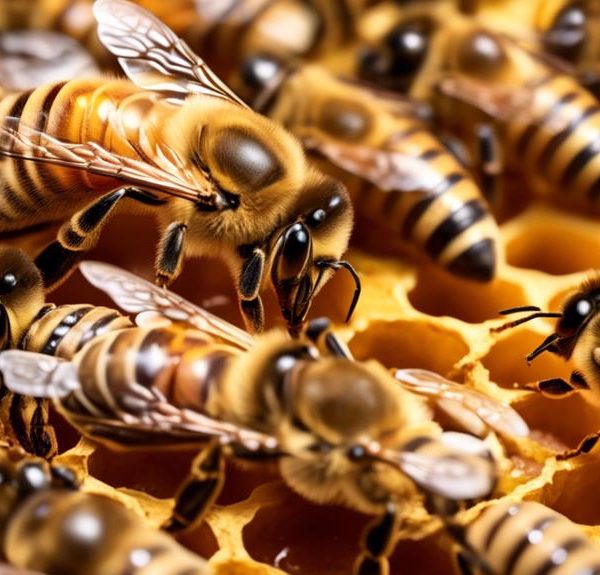Crack the code of bee communication and discover if killing one truly attracts more, in this fascinating exploration of bee behavior.

Does Killing Bees Attract More Bees?
Navigating the world of bees is much like unraveling a complex tapestry, each thread interwoven with myths and facts.
You've likely heard the claim that killing a bee attracts more bees, but have you ever stopped to question its validity? This assertion is rooted in the idea that bees, much like their insect counterparts, communicate through a network of signals, particularly when under threat.
But is there scientific evidence to support this notion, or is it just another unfounded myth?
Ponder this intriguing question as we embark on this exploration of bee behavior and communication.
Key Takeaways
- Bees communicate through movements called the 'waggle dance' to provide information about food sources.
- Killing a bee releases distress signal pheromones, which can lead to more aggressive behavior in nearby bees.
- Bees play a critical role in pollination, and their decline can disrupt the food chain and impact the diversity and abundance of fruits, vegetables, and nuts.
- Debunking myths, killing a bee does not result in a large influx of bees, and bees are attracted to nectar-producing flowers rather than sweet scents.
Understanding Bee Communication
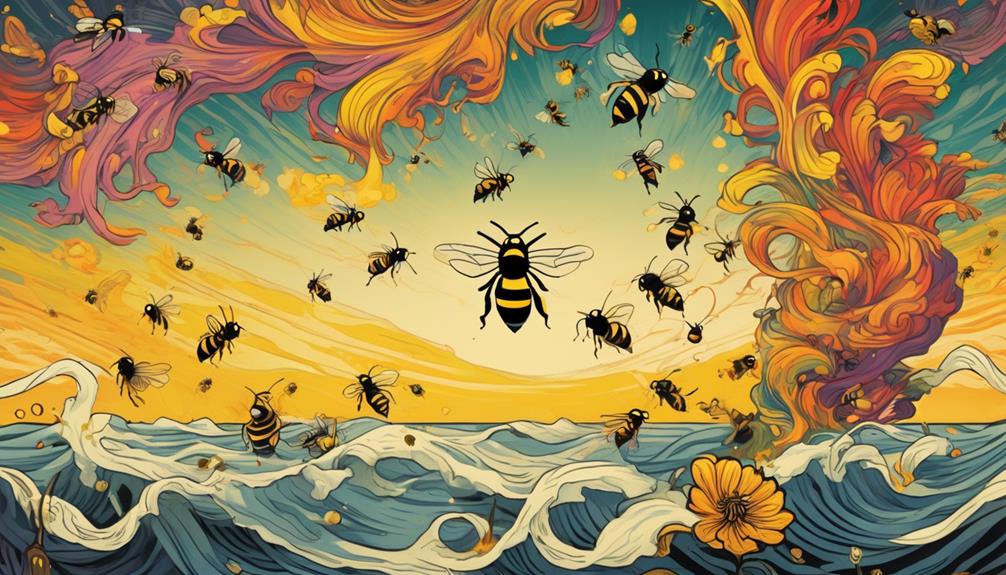
While it may seem bewildering, bees communicate effectively through their movements, a phenomenon known as the 'waggle dance', delivering precise information about food sources to their fellow hive members. You'd be amazed to discover that these complex, sophisticated creatures have developed a language of their own, encoded in the vibrations and movements of their bodies.
In essence, the 'waggle dance' is a figure-eight pattern. The bee that has found a food source will return to the hive and perform this dance on the honeycomb. The direction of the dance provides information about the direction of the food source in relation to the sun, while the length and speed of the dance communicate the distance to the food source. It's a remarkably accurate way of transmitting complex navigational data.
In the events of bee deaths, this communication system is crucial. Bees are attracted to the locations indicated by the 'waggle dance', including areas where fellow bees may have died due to pesticides or other threats. Understanding this intricate communication system can provide insights into bee behavior and potentially help in developing strategies for their conservation.
The Science Behind Bee Attraction
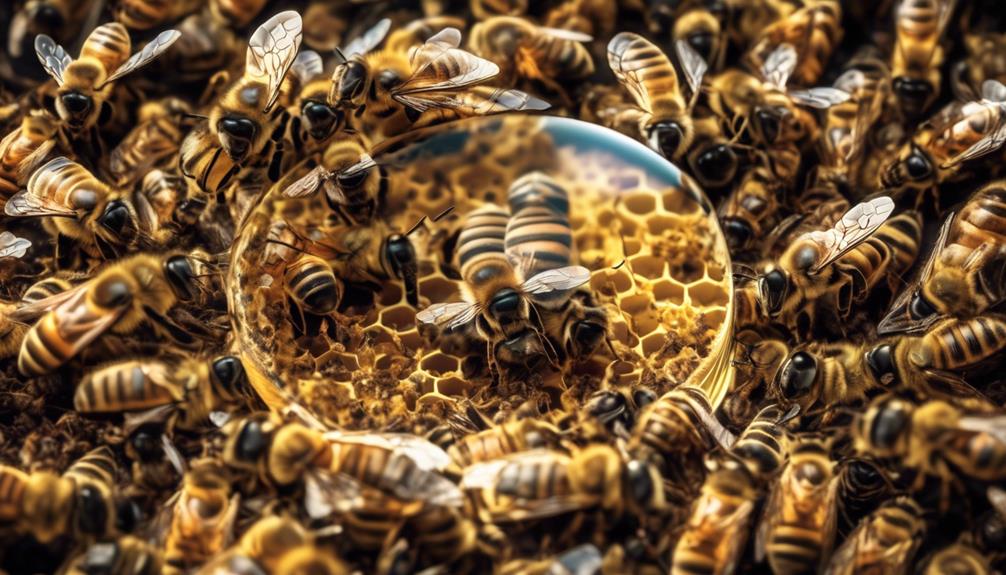
In examining the science of bee attraction, you'll find that these insects have a keen sense of smell, using pheromones to communicate and locate food sources, mates, and their hive. Worker bees release trace pheromones when foraging, which is picked up by other bees in the hive, enticing them to follow the scent trail to the food source. This highly evolved chemical communication system is vital for the survival of a bee colony.
Now, when a bee is killed, it releases an alarm pheromone. This volatile chemical signal triggers a defensive response in nearby bees, inciting them to swarm and attack the perceived threat. So, it's not that killing a bee attracts more bees but rather alerts them to a potential danger.
This is where the science behind bee attraction becomes interesting. If you've ever swatted at a bee and found yourself suddenly surrounded by more of them, you've experienced the effects of this alarm pheromone. It's a distress call, a rallying cry, compelling other bees to come to the defense of their hive. Understanding this science can help you interact with bees in a safer, more informed way.
Pheromones: The Bee's Distress Signal
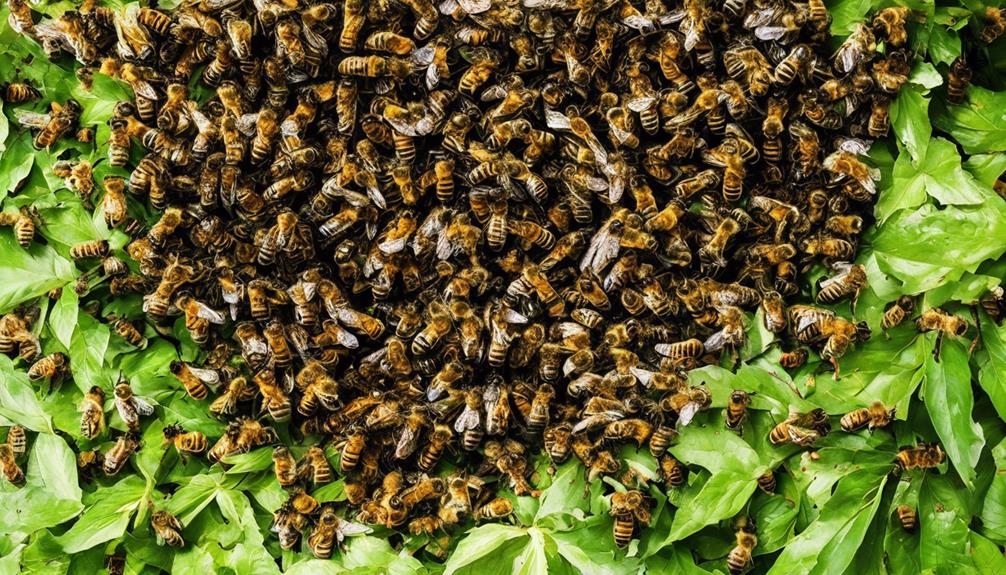
You've seen how the pheromones play a crucial role in the bee's world for communication and survival, so let's zero in on the distress signal pheromones, the bee's alarm system when confronted with danger.
These alarm pheromones, primarily composed of isoamyl acetate, are released when a bee stings an invader. This chemical signal, similar to the scent of ripe bananas, alerts other bees to the threat.
Once a bee detects this distress signal, an immediate response is triggered. The bee becomes more aggressive and alert, ready to defend the hive. The strength of this response can vary depending on the concentration of released pheromones. The more bees stinging, the stronger the alarm signal, and the greater the resultant aggressive behavior.
Implications of Killing Bees
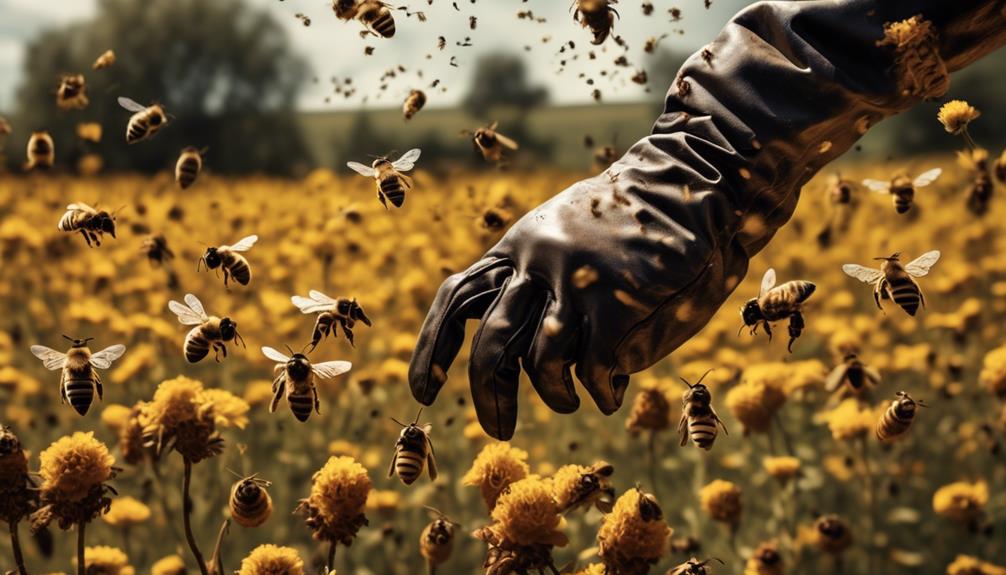
Often, the act of killing bees triggers an unexpected and significant chain of events. It not only amplifies the distress signal, but also has far-reaching impacts on the ecosystem. Killing a bee releases a pheromone that signals danger to other bees, causing them to swarm the area. This behavior, while understandable as a defense mechanism, can escalate the situation and lead to more bee deaths.
But what's the big deal, you might ask? Bees play a critical role in pollination, ensuring the reproduction of many plants. Without bees, you'd see a noticeable decline in the diversity and abundance of fruits, vegetables, and nuts. This wouldn't just affect your diet, but also the economies of many countries dependent on these crops.
Moreover, the loss of bees can disrupt the food chain. Many animals, including birds and small mammals, rely on the seeds and fruits that result from bee pollination. If bees disappear, these animals could starve, leading to a ripple effect up the food chain.
Debunking Bee-Related Myths
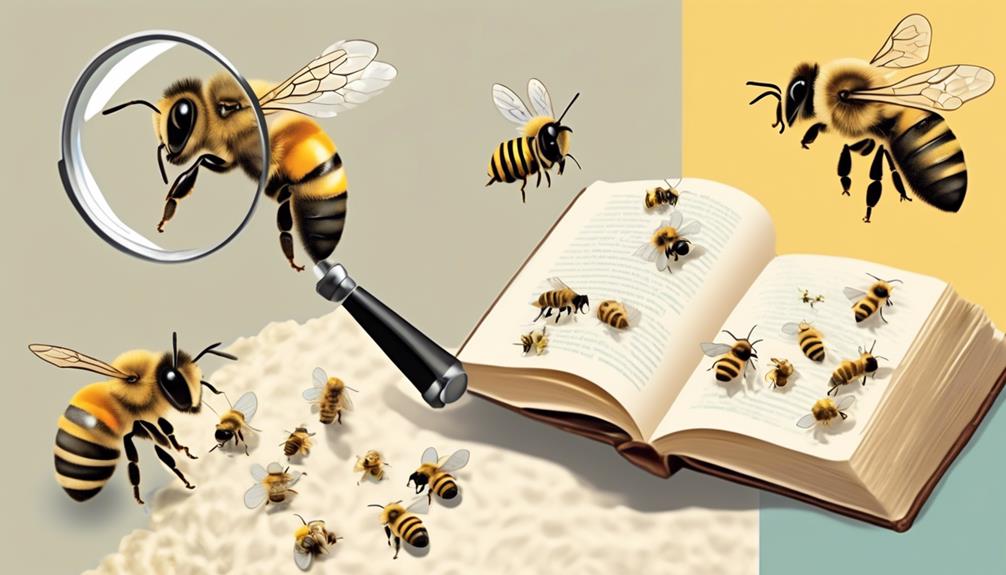
While the implications of killing bees are quite profound, there's also a need to address and debunk several myths that have permeated our understanding of these crucial pollinators.
One common misconception is that all bees sting and are aggressive. In truth, many species are docile and only resort to stinging as a last defense. Male bees, or drones, can't sting at all.
Another myth is that bees die immediately after they sting, but this is specific to honey bees. Most other species can sting multiple times without dying.
You might've heard that killing a bee attracts more bees, but this is only partly true. Bees release pheromones when in danger, which can attract nearby bees. However, this doesn't result in a large, swarming influx as often depicted.
Additionally, the idea that bees are attracted to sweet scents is somewhat misleading. Bees are drawn to nectar-producing flowers, which aren't always the sweetest smelling.
Frequently Asked Questions
What Specific Steps Can One Take to Prevent Bees From Being Attracted to Their Homes?
To prevent bees from being attracted to your home, you'll need to take several steps.
First, remove potential food sources like open garbage cans or exposed fruits.
Second, seal openings in your home's structure where bees could build nests.
Also, consider not using floral or sweet scents, as these can attract bees.
Lastly, maintaining a regular pest control routine can keep a bee problem from starting.
Are There Any Natural Predators That Can Control the Bee Population?
Yes, there are several natural predators that can control the bee population. Birds, spiders, and other insects such as wasps and dragonflies are known to prey on bees.
Even some species of mammals like skunks and badgers will eat bees. However, it's important to remember that bees play a crucial role in pollination, so their population control should be managed carefully.
You wouldn't want to disrupt the balance of your local ecosystem.
Is There a Particular Season When Bees Are More Attracted to Certain Areas?
Yes, there's a season when bees are more attracted to certain areas. In spring and summer, when flowers are in bloom, bees migrate to these regions. They're attracted by the abundance of nectar and pollen, which they use for food.
Also, during these warmer months, bees are in their active breeding phase, which requires additional food resources. So, you'll notice a higher concentration of bees in areas rich in flowering plants during these seasons.
What Are the Best Ways to Safely Remove a Bee Nest Without Killing the Bees?
You're wise to consider safe methods to remove a bee nest without causing harm. Always seek professional help if possible.
If you must do it yourself, suit up for protection. Try to relocate the nest at night when bees are less active. Use smoke to calm them.
Don't shake or knock the nest during removal. Secure it in a container and relocate it far from your home.
Always remember, bees are vital for our ecosystem.
Can Bees Become Immune to Certain Pesticides Over Time?
Yes, bees can indeed become immune to certain pesticides over time. Just like bacteria evolve to resist antibiotics, bees can adapt to harmful substances. This is a process called pesticide resistance, and it's a major concern in the world of agriculture.
If you're using pesticides and notice they're becoming less effective, it's possible the bees have developed a resistance. It's crucial to rotate pesticides to prevent this adaptive response.
Conclusion
So, does killing bees attract more bees? Yes, it certainly does. When a bee gets killed, it emits a distress pheromone that calls for reinforcements. This isn't some old wives' tale, but a fact backed by scientific study.
Therefore, it's crucial to avoid harming bees whenever possible. Not only for this reason, but also for the vital ecological role they play. Dispelling myths and understanding the science of bees is key to their protection and conservation.


